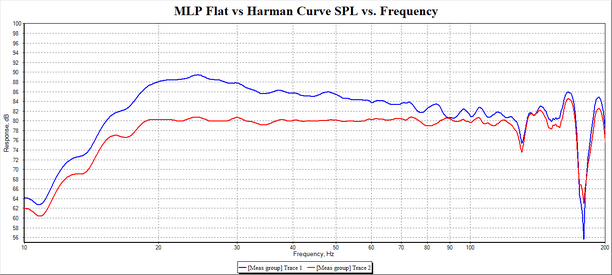Hello folks,
It seems like this hobby and Al Pacino's line from The Godfather 3 ("Just when I thought I was out, they pull me back in.") have a lot in common.
What I'm getting at is that for the most part, many consumers (and their spouses) are perfectly happy with the default settings on their gear, be it a tv, or a sound system. Many are oblivious to how much better it could look or sound if only they spent some time tweaking.
But this really doesn't apply to many of the folks reading this. We are tinkerers! And therefore, despite things seeming fine, we can't help but go back and look under the hood to see what else we can get out of it.
We are tinkerers! And therefore, despite things seeming fine, we can't help but go back and look under the hood to see what else we can get out of it.
In my case, I was perfectly fine enjoying the most recent calibration of my 7.4.4 setup... But a few forum chats and Youtube videos later, here I am once again tinkering with the system
Over the years I've heard "trust your ears" as advice when setting up audio. Good advice, but one problem with this advice is that without a reference point, I might not know if I'm hearing the correct thing to begin with. I'm sure that if someone with a "trained ear" listened to the system, they could point out the good and the bad in the system, but to the average joe most systems (regardless of accuracy) will probably sound OK.
So along comes REW, and now I'm doing measurements and saying "AHA" when I see a big peak or a big dip in the graph. This discovery is bittersweet because it introduces yet another issue... according to experts, our ears and brain don't process sound the same way that a microphone does (since the brain can filter out certain reflections etc.), while the microphone picks up everything which the REW graph then converts into a visual representation of it. And the problem with this is that supposedly not every peak or dip on the graph is audible to our ears/brain. Therefore, something like a very narrow but deep dip on the graph can sometimes be ignored... or can it??
I mean, even if you ignore some of those things, there are others that one should address, but how do we know which to address and more importantly where and how do we do it??
So then they say, use a mirror to find the first reflection points and treat those... But then someone like Dr. Floyd Toole says don't treat all of the early reflections! So now it seems like we need both a good set of trained ears as well as an expert at interpreting graphs... the problem just doubled!

So back the forums I go, looking for who has a good walkthrough on how to best interpret these graphs so that we can better understand what to ignore and what to treat and how.
I know I'm not the first to go through this, and in the forums I see a lot of pretty rooms with different types of treatment mounted in what seems like the same "standard" locations, this makes me wonder... how much of this is real vs placebo?
Anyways, that's my rant. Hopefully at some point I will either wave the white flag and surrender under the notion of "it is what it is!" and enjoy the system as is, OR keep tinkering and learning with the help of others.
It seems like this hobby and Al Pacino's line from The Godfather 3 ("Just when I thought I was out, they pull me back in.") have a lot in common.
What I'm getting at is that for the most part, many consumers (and their spouses) are perfectly happy with the default settings on their gear, be it a tv, or a sound system. Many are oblivious to how much better it could look or sound if only they spent some time tweaking.

But this really doesn't apply to many of the folks reading this.
 We are tinkerers! And therefore, despite things seeming fine, we can't help but go back and look under the hood to see what else we can get out of it.
We are tinkerers! And therefore, despite things seeming fine, we can't help but go back and look under the hood to see what else we can get out of it.
In my case, I was perfectly fine enjoying the most recent calibration of my 7.4.4 setup... But a few forum chats and Youtube videos later, here I am once again tinkering with the system
Over the years I've heard "trust your ears" as advice when setting up audio. Good advice, but one problem with this advice is that without a reference point, I might not know if I'm hearing the correct thing to begin with. I'm sure that if someone with a "trained ear" listened to the system, they could point out the good and the bad in the system, but to the average joe most systems (regardless of accuracy) will probably sound OK.
So along comes REW, and now I'm doing measurements and saying "AHA" when I see a big peak or a big dip in the graph. This discovery is bittersweet because it introduces yet another issue... according to experts, our ears and brain don't process sound the same way that a microphone does (since the brain can filter out certain reflections etc.), while the microphone picks up everything which the REW graph then converts into a visual representation of it. And the problem with this is that supposedly not every peak or dip on the graph is audible to our ears/brain. Therefore, something like a very narrow but deep dip on the graph can sometimes be ignored... or can it??

I mean, even if you ignore some of those things, there are others that one should address, but how do we know which to address and more importantly where and how do we do it??

So then they say, use a mirror to find the first reflection points and treat those... But then someone like Dr. Floyd Toole says don't treat all of the early reflections! So now it seems like we need both a good set of trained ears as well as an expert at interpreting graphs... the problem just doubled!


So back the forums I go, looking for who has a good walkthrough on how to best interpret these graphs so that we can better understand what to ignore and what to treat and how.

I know I'm not the first to go through this, and in the forums I see a lot of pretty rooms with different types of treatment mounted in what seems like the same "standard" locations, this makes me wonder... how much of this is real vs placebo?
Anyways, that's my rant. Hopefully at some point I will either wave the white flag and surrender under the notion of "it is what it is!" and enjoy the system as is, OR keep tinkering and learning with the help of others.

Last edited:











 I calibrate, listen, measure, listen again.... leave it for a week or months, then just when I thought I was out... it pulls me back in!
I calibrate, listen, measure, listen again.... leave it for a week or months, then just when I thought I was out... it pulls me back in!



